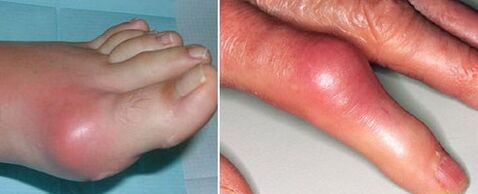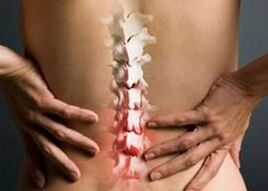
Joint pain can make life unbearable.After a visit to the doctor, a record of the diagnosis of joint disease or arthritis will appear on the outpatient card.
People far from medicine have little idea of the difference between arthritis and joint disease, and mistakenly believe they are the same disease.
In fact, these are two completely different pathological processes that can occur simultaneously.
Arthritis
Arthritis refers to a degenerative-inflammatory process and develops due to age-related changes in the structure of cartilage tissue.
It affects the moving joints of large bones and, less commonly, the finger joints.
Arthritis appears in joints

The main cause of pathological changes is metabolic disorders in cartilage.Violation of cartilage nutrition leads to irreversible loss of proteoglycans and loss of tissue elasticity.
Dystrophic changes in cartilage entail pathological changes in the structure of the articular surfaces of bones.Over time, the degenerative process spreads to the tissues around the joint.
Types of joint diseases
Based on their origin, they distinguish between primary and secondary joint diseases.
The primary form affects previously healthy joints and is a consequence of age-related changes and inadequate physical activity.The time when the first symptoms of arthritis appear depends on genetic predisposition, characteristics of occupational activities and lifestyle.
Traditionally, people over 45 years of age were considered at risk, but there is now a steady trend toward early disease.The disease mainly affects women, but with age, gender dependence gradually lessens.
Secondary arthritis develops against the background of a previous injury or some disease of a different nature, including:
- autoimmune process;
- metabolic disorders;
- endocrine dysfunction;
- diseases of joint structure;
- genetic diseases;
- inflammatory processes.
Secondary arthritis is not related to aging and can occur at any age.
There are three stages in the development of the disease.
In the first stage, changes in synovial fluid occur.Cartilage nutrition is disrupted and its stress resistance is reduced.The cartilage surface appears rough, inflammation develops, accompanied by pain.
As the disease progresses to the second stage, the pain becomes habitual and the accompanying inflammatory process becomes wave-like.The cartilage begins to deteriorate and compensatory bone growth is formed at the edges of the joint area.Periarticular muscles are involved in pathological processes.
The third stage is characterized by severe deterioration of articular cartilage with areas of complete tissue destruction.The degenerative process leads to irreversible anatomical changes, including changes in the limb axis.The function of the ligamentous apparatus is disrupted, abnormal mobility appears in the affected joint against the background of limited natural mobility.
According to the location of the lesion, they are distinguished:
- gonorrhea,
- coxarthrosis,
- degenerative spondylosis,
- Arthritis of the intercostal joints of the hand.
Other localized sites of pathology are relatively rare.
Gonorrhea, knee arthritis
Risk factors for developing this disease include genetic factors, overuse or occupational knee injuries.
According to statistics, joint damage to the knee joint is more often diagnosed in women.
In the early stages of development, the disease is manifested by discomfort in the affected joints and pain.Depending on the cause of the lesion, several forms of gonorrhea are distinguished.
Some of them are characterized by a lack of progress over long periods of time;The patient's condition remained stable for decades.However, there are also diseases that develop rapidly and lead to loss of mobility of the affected limb.
Coxathrosis, arthritis of the hip joint

With this disease, a classic clinical picture of arthritis is observed.
The first symptom of coxarthrosis is discomfort in the hip joint after physical activity.
As coxarthrosis progresses, pain increases, stiffness and limitation of movement appear.
Patients with severe forms of coxarthrosis will avoid using the affected limb, avoid stepping on it, and when standing still, choose positions that are least painful.
Spinal arthritis, spondylosis

Spondyloarthrosis refers to pathologies that develop against the background of degenerative processes in the intervertebral discs.
The first and main symptom of degenerative spine disease is pain when bending from side to side or back and forth.
When a person is in a horizontal position, the pain gradually decreases.
Over time, without adequate treatment, mobility of the affected part of the spine may be completely lost.
If not treated appropriately, degenerative spine disease can cause disc herniation and joint deformity.In severe cases, the patient loses the ability to make normal movements and becomes disabled.
Arthritis of the interphalangeal joints of the hand
The disease mainly affects women.Among the early symptoms of arthritis are pain when exposed to cold water and when stretching the fingers.Over time, joints become deformed due to compaction of neighboring tissues and the formation of characteristic bony masses.
The disease has a wave-like progression. In the acute stage, the joints become swollen, partially lose mobility, and tactile sensitivity may be reduced.
Treatment of arthritis
It is impossible to completely cure osteoarthritis with modern medicine.However, timely diagnosis and complex treatment aimed at preventing further destruction of cartilage tissue stabilizes the condition of the affected joint and significantly improves the patient's quality of life.
First of all, it is necessary to reduce the load on the musculoskeletal system.Doctors recommend avoiding lifting heavy objects, staying in one position for long periods of time, and limiting time spent on your feet.For overweight people, losing weight is very important.
In the treatment of joint diseases with drugs, the following are used:
- non-steroidal anti-inflammatory drug, administered internally in the form of injections or tablets and externally as part of ointments.Forms and regimens of use are prescribed depending on the patient's condition;
- drugs belonging to the group of chondroprotectors to maintain the condition of cartilage tissue;
- anti-inflammatory steroids in the form of intra-articular injections.Indicated in severe cases;
- hyaluronic acid preparations to improve joint mobility.
In addition, people use warming compresses and ointments, drugs that activate metabolic processes and blood microcirculation, antioxidants and trace element-vitamin complexes with selenium and prescribe physiotherapeutic treatment.In severe cases, surgical intervention is required.
During remission, the patient is recommended to carry out a course of exercise, selected in accordance with the characteristics of the course of the disease.
Arthritis
Arthritis is an inflammatory disease that occurs as an underlying disease, a comorbid condition, or as a complication of a previous infectious disease.
Arthritis appears in joints

Among the typical causes of the inflammatory process in the joints:
- metabolic disorders in the body;
- vitamin deficiency;
- injury;
- autoimmune disease;
- Infectious lesions due to many different causes.
Unlike joint disease, the pathological processes in arthritis affect the tissues around the joints.The appearance of pain does not depend on physical activity and body position and often causes discomfort at night.
The joint noise characteristic of the early stages of arthritis is rarely observed.General blood tests show the presence of an inflammatory process;When examining joints, characteristic degenerative changes in cartilage are rarely detected.
The common symptom of both diseases is pain.Any unusual sensations and discomfort in the joints are a good reason to consult a doctor.The success of treatment largely depends on timely detection and treatment of the disease.
Types of arthritis
Based on their appearance, arthritis is divided into several types:
- infectious arthritis.They develop as independent diseases due to wound infection (primary infectious arthritis) or when pathogens enter the bloodstream from organs affected by infection (secondary infectious arthritis);
- rheumatoid arthritis.This chronic disease has an infectious autoimmune origin and usually develops in middle-aged and older people;
- gouty arthritis.The inflammatory process is stimulated by microtrauma on the cartilage surface by uric acid salt crystals formed in the joint capsule;
- traumatic arthritisdevelops as a response to trauma, but may develop several years after its consequences have been eliminated;
- juvenile rheumatoid arthritisaffects children under 16 years of age.The cause of this disease is still unknown.The course is chronic, progressive.
The process of arthritis can be acute or chronic.In the acute stage, the disease develops rapidly, there is severe swelling, severe pain in the affected area, local or whole body temperature increases.
With chronic arthritis, symptoms gradually increase and the disease can progress over years.If treatment is not timely or appropriate, acute arthritis can become chronic.
According to the characteristics of the lesions, monoarthritis and polyarthritis are distinguished.In monoarthritis, the damage is localized to one of the joints;When several joints are involved in the pathological process, a diagnosis of polyarthritis will be made.
Arthritis treatment
The treatment strategy for arthritis depends on the cause of the disease and the severity of the patient's condition.For septic arthritis, the patient is prescribed a course of antibiotics or other drugs, depending on the nature of the pathogen.
To eliminate inflammation, nonsteroidal anti-inflammatory drugs are used as injections, tablets, and/or applied topically as ointments or gels.
In addition, drugs belonging to the group of chondroprotectors, antihistamines and general restoratives can be prescribed.In some cases, patients are prescribed drugs that help improve blood microcirculation.
In addition to drug treatment, the patient is prescribed a course of physiotherapy and during the period of remission, a set of exercise therapy exercises.
In severe and progressive cases, surgery may be required.
Without the help of professionals, arthritis and arthrosis can lead to disability.
Self-medication to treat joint diseases is contraindicated;In the majority of cases, the patient's condition worsens.
Any change in joint function is a reason to see a doctor.
Preventive measures
To prevent arthritis and osteoarthritis, it is important to optimize physical activity, avoiding overload.People diagnosed with the disease as well as those at risk of the disease need to adjust their diet towards health, reduce alcohol consumption and stop smoking.
People prone to obesity should maintain normal body weight, since increased load on the musculoskeletal system can cause or accelerate pathological changes.
To promptly detect the disease in its early stages, it is important to undergo regular preventive examinations.

























